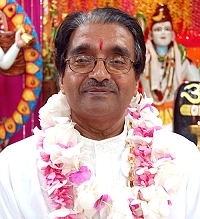From an interview with Paramacharya of SWAHA, H.H. Pt. Hardeo Persad
Divali or Deepavali means ‘a festival or row of lights’. Thus, any festival that includes lights can be referred to as a divali. Divali as a Hindu observance occurs in the month of Kaartik on the day of the new moon, Amaawasya. There are many origins stories for the celebration of Divali. Some declare that it is because of the appearance of the Goddess Lakshmi from the ocean of milk. Some say it is due to the return of Shri Raam, Sita Maa and Lakshman to Ayodhya after exile. Others say it is the celebration of the victory of Shree Krishna over Narakasura. In Sanaatan Dharma, we observe the festival as the worship of Lakshmi Devi.
In the mythology related to the appearance of Goddess Lakshmi, there is an eternal battle between the Devtas and demons. As neither side could attain victory, they were advised to churn the ocean of milk, ksheer sagar, using the Mandarachal mountain as a churning rod, Kurma the avatar tortoise as the base, and the snake Vasuki as a rope.
After the ocean was churned, 14 items emerged from the ocean, one of whom was the Goddess Lakshmi. She represents the universal message of light, enlightenment and empowerment that transforms spiritual darkness to self-illumination and spiritual evolution.
Lakshmi is referred to as the shakti of Bhagavan Vishnu, the sustaining aspect of Divinity. Shakti is power or energy in both its static and dynamic forms. It is that force that guides the creation, sustenance, destruction and re-absorption of all life. In humans, this shakti is present as the energy of will, knowledge and action. Devi symbolizes the higher Self, the state of positive qualities, purity, awareness and spirituality. She is Chid Shakti or pure consciousness. As Durga Devi, she is Iccha Shakti, the willpower that transcends our negative qualities and as Saraswati Devi she is Kriyaa Shakti or right activity. As Lakshmi Devi, she symbolizes Gyaan Shakti; through Her we earn the wealth of knowledge.
Lakshmi Devi is depicted as standing on the lotus flower with coins flowing from her hands. The intense churning of the unconscious and the sincere worship of Lakshmi Devi grants one the wealth of knowledge that leads to spiritual evolution. Such a sacrifice brings a level of affluence that surpasses mere material acquisition. Just as Lakshmi Maataa emerged from the churned ocean, the seeker’s sacrificial efforts bring the shat sampat or the six forms of wealth that result in a greater awareness of the energy of knowledge within us. These forms of wealth are: faith, serenity, endurance, tranquillity, control of the senses and renunciation of selfish actions and desires.
When we pursue the path of intense churning within, we are lifted from the state of spiritual poverty to the richness of inner light. Our belief is strengthened and the willingness to perform positive action creates beautiful adornments in our lives. Indeed, we become illuminated gems of Lakshmi Maataa, reflecting the wealth of knowledge. Our light shines from within and we become a source of empowerment and illumination to others.



